An open window into the comings and goings of students and their trees attending our regular weekend and midweek bonsai classes under the ever watchful eyes of John Hanby.
Classroom Corner – Repotting….A tale of two Pines
These two large old Pines were brought to the same workshop in March by two different students. One was a Scots Pine (Pinus Sylvestris), whilst the other was a Japanese White Pine (Pinus Pentaphylla). They had both been brought specifically for advice and help on repotting.
First up was the Scots Pine. The tree had not been repotted
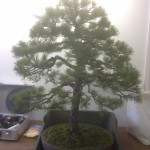 for a good number of years and was not draining well. It’s colour was not as vibrant as it should be.
for a good number of years and was not draining well. It’s colour was not as vibrant as it should be.
There was a heavy natural moss growth on the soil surface and below this the compost was distinctly “sludgy”. The tree was removed from the pot with the help of a root saw.
The compost was very heavy being soil based but with an element of coarse gravel. It was very wet partly due to the recent period of prolonged bad weather.
Apart from the compost being too heavy it soon became apparent what the main cause of the problem was. My student’s previous bonsai teacher had advocated covering the entire base of the pot with a sheet of mesh rather than cutting small squares to cover the drainage holes. The problem with this is that the roots grow into the drainage mesh which then becomes a solid mat, blocking the drainage holes and preventing water escaping as it should. Removing this sheet of mesh after several years at the next repotting inevitably results in greater damage being done to the rootball.
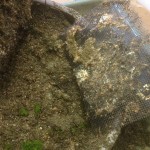
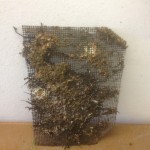
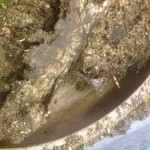
Normally I would leave the outer roots intact and remove the older poorer soil from the 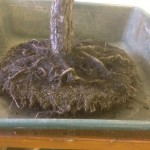 centre of the rootball. Because of the drainage problem the outer root growth is not strong enough.
centre of the rootball. Because of the drainage problem the outer root growth is not strong enough.
Apart from dealing with the poor soil/roots the rootball is generally left intact and holes are made with a rounded spike around the centre of the tree to ensure that water can penetrate the compost and roots below.
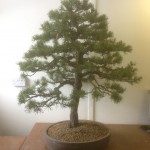 The tree is repotted using a larger size particle in a mixture of 50/50 akadama and bims (a German river gravel)
The tree is repotted using a larger size particle in a mixture of 50/50 akadama and bims (a German river gravel)
When the tree is next repotted it should be possible to leave the outer section untouched as this should be full of strong roots. The soil in the centre can then be removed and replaced with fresh compost.
The White Pine was repotted approximately 4 years ago. It had put on a lot of growth and appeared to be in good strong condition. It was removed from the pot so that the condition of the rootball could be assessed.
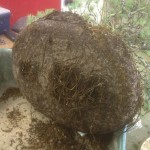
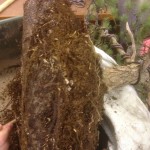
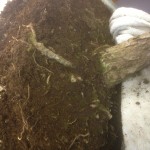
There is an abundance of strong healthy roots especially around the outside and underneath but the centre of the rootball looks very compacted/solid and probably contains some original growing field soil.
It is decided to leave the outer rootball untouched and remove all the soil from the central area around the base of the trunk. You can see that some of the compost removed is poor, dry and just like garden soil.
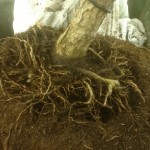
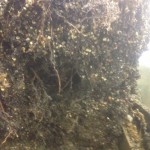
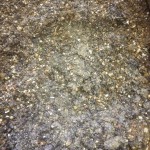
The hole is filled in with a larger particle size of 50/50 akadama and bims. This will allow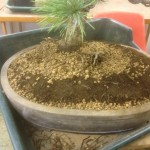 better drainage whilst the roots recover and start growing again. It will also promote more extensive fine rooting.
better drainage whilst the roots recover and start growing again. It will also promote more extensive fine rooting.
Same class, two large pines…for advice on repotting. Ideally I would have liked to have removed the older soil from the centre of the rootball on both trees. On one tree it was possible, on the other tree it was not.
You see how important it is to assess the condition of the rootball and what is happening……where are the strong areas ……..where are the
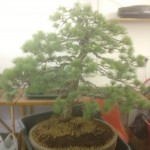
weak/problem areas.
Only then can you decide on the best course of action to develop and maintain a healthy root system capable of sustaining the future development of the tree whilst promoting health and maintaining vigour.
You have to refrain from repotting all your trees in the same robotic fashion on automatic pilot without really thinking about what you are actually doing.
Trees and their roots are like us……..every one is different, as individual as we are…….and often every bit as temperamental!!!
 for a good number of years and was not draining well. It’s colour was not as vibrant as it should be.
for a good number of years and was not draining well. It’s colour was not as vibrant as it should be. centre of the rootball. Because of the drainage problem the outer root growth is not strong enough.
centre of the rootball. Because of the drainage problem the outer root growth is not strong enough. The tree is repotted using a larger size particle in a mixture of 50/50 akadama and bims (a German river gravel)
The tree is repotted using a larger size particle in a mixture of 50/50 akadama and bims (a German river gravel) better drainage whilst the roots recover and start growing again. It will also promote more extensive fine rooting.
better drainage whilst the roots recover and start growing again. It will also promote more extensive fine rooting. weak/problem areas.
weak/problem areas.
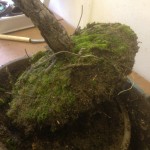
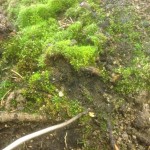
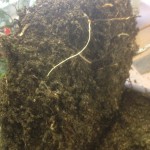









roy hicks
April 13, 2013 at 8:13 amexcellent set of pictures & information to go with them, just proves how important good compost is & correct potting methods are.